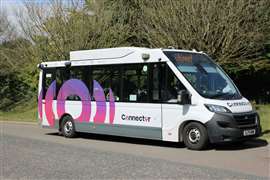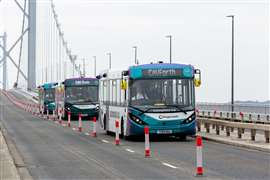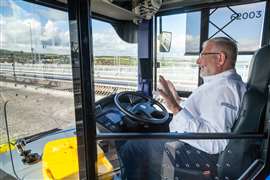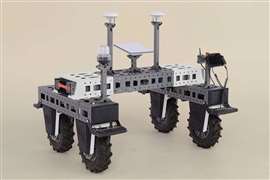Read this article in Français Deutsch Italiano Português Español
Fusion Processing and self-driving buses
04 August 2025
Fusion Processing is the company behind the CAVStar autonomous driving system now being deployed on a series of bus routes across the UK. Julian Buckley speaks with CEO Jim Hutchinson to find out more
 Connector Bus used on the Cambridge service (All photos provided by Fusion Processing)
Connector Bus used on the Cambridge service (All photos provided by Fusion Processing)
“The wheel moves without a driver and people find that strange at first, but very quickly it becomes very ordinary,” says Jim Hutchinson, CEO and founder of Fusion Processing, the company behind the CAVStar Level 4 automated drive system.
The company recently announced that it is to start a long-term autonomous bus service in Cambridge, UK. While this is the first service which will operate in a ‘live’ urban area, it’s not the first time the company has been involved in running an autonomous transit service.
Back in 2023, bus operator Stagecoach launched what was acknowledged as the world’s first regular autonomous bus service. The project involved five self-driving vehicles running on a route in Scotland between Fife and Edinburgh, which included crossing the Forth Road Bridge. Despite the project being considered a success, the service was closed in February this year.
“When we were looking at the route in Scotland, our analysis said there would be customer demand and that it was commercially viable. But that was pre-COVID; over the COVID period people stopped using buses and passengers never really returned. We did get a lot of data from operating the service, though,” says Hutchinson.
 Jim Hutchinson, Fusion Procesing
Jim Hutchinson, Fusion Procesing
At the same time as the service in Scotland the company also deployed buses on a route in Oxfordshire, where passenger numbers were better. “Admittedly, part of that was because the service was free,“ says Hutchinson. “Also, it ran on a loop around a business park that included Oxford Parkway train station, which meant a lot of customers. But it certainly showed that there’s no fundamental issue with people not wanting to get on a self-driving bus.”
Hardware and performance
Fusion Processing worked with bus manufacturer Alexander Dennis on development of the autonomous vehicles used in Scotland. The bus builder will be supplying two of the initial three vehicles used on the route in Cambridge.
The self-driving system used on the buses consists of cameras, LiDAR and RADAR, with the addition of ultrasonic sensors. As Hutchinson explains, each of these has its own strengths and weaknesses, so combining all systems delivers the most accurate portrayal of what is happening on the road ahead.
“The system delivers very accurate data in all kinds of weather conditions,” says Hutchinson. “There are arrays around the vehicle which give a full 360-degree view. CAVStar acts as the brain of the system. It takes feeds from the various sensing systems and overlays them to get a complete picture.”
 Self-driving buses have an accuracy between one and three centimetres
Self-driving buses have an accuracy between one and three centimetres
The system has an overall accuracy level of between one and three centimetres (up to one inch). This supports driving with live traffic, negotiating complex road infrastructure (such as roundabouts), while also allowing navigation around vulnerable road users including pedestrians and cyclists. “There’s usually more tolerance than that in road environments, but it’s good to have that accuracy,” explains Hutchinson.
He says that it hasn’t been necessary to upgrade any road markings or other road signals to safely operate the self-driving buses. “We haven’t had to repaint lines, but there are other things you can do which are quite useful,” he says.
“For example, the system can read traffic lights and it knows when it has to stop and when it can go. But some traffic signals can communicate directly with the vehicle, not only sharing what they’re doing now, but what they’re going to do. If you’ve got that information, the vehicle can time its approach so it doesn’t have to stop. Over time, that can save a lot of fuel.”
In general, he says that while some painted road markings will be worn, the onboard systems are sufficiently sensitive to recognise those markings and use that information. “We’ve not had any problems so far, the vehicle can manage to negotiate roads with the markings and signals which are already there.”
Currently it is a legal requirement in the UK for a safety driver to be onboard a bus while it is operating autonomously on public roads. The Automated Vehicles Act, which applies to the use of any autonomous vehicle on UK roads, was passed in 2024. Defining related responsibilities, it is hoped that secondary legislation covering implementation will be passed by 2026 or ’27.
Onboard drive system
Hutchinson describes the system which physically drives the buses as “quite complex”. Continuing, he says the vehicles are controlled by a chain of operations; sensors collect data, which is then processed so the vehicle knows where it is, the direction of travel, upcoming manoeuvres, etc. A fleet management system controls the full vehicle route so that it understands where it needs to get to and what should be done to achieve that goal.
 Buses fitted with Fusion Processing autonomous driving system on the Forth Road Bridge
Buses fitted with Fusion Processing autonomous driving system on the Forth Road Bridge
As for physical movement of the vehicle controls, a series of actuators translate data into turning and pushing of the steering wheel and pedals. Hutchinson says that there is built-in redundancy across the system so that if a steering or brake actuator fails then the second unit will instantly take over.
Systems such as indicators (or turn signals) don’t need to have the steering column stalk moved up or down to signal left or right. Instead, CAN bus can send a signal to a relay and that starts the indicator.
“The CAN bus is effectively the boundary of our system,” says Hutchinson. “We’re using that to send messages to all the actuators, the related systems and anything else we need to control.”
Asked if at some point he sees the steering wheel and pedals being removed from the vehicle, he says that if any of the self-driving systems are damaged the bus will still be able to bring itself to a safe stop. But it will still need a human driver to bring the bus back, so maybe the full suite of controls will remain even into the future.
Adding hardware
Working with the Alexander Dennis and other OEMs to locate the hardware within the vehicle posed no major difficulty, largely due to the size of the vehicles. Hutchinson observes that it would be more difficult on a passenger car or light van.
“It’s relatively easy to integrate our system. We want to be easy to partner with, we don’t want to add unnecessary difficulty for the vehicle OEMs.”
As it stands the system is added on a retrofit basis, but Fusion Processing is working with Alexander Dennis to develop a process where the autonomous system is ‘designed in’ and installed during production.
Hutchinson says that there are plans to introduce the option to purchase a bus off the assembly line fitted with a self-driving capability before the UK legislation comes into effect in 2027, while there are also plans to deliver versions with left-hand drive.
Fuel and energy savings
When the project in Scotland started, there were no electric buses that could achieve the required duty cycle. Interestingly, the operation returned a 7% saving in diesel fuel over what was expected, all without any specific mapping intended to achieve improved economy.
Hutchinson puts forward that it would be possible to achieve a 20% energy savings when using the self-driving system on an electric bus by optimising the anticipated brake and acceleration phases across a given route. That can help to improve overall range, or another option could be to use a smaller, lighter battery pack which could help reduce costs.
Passengers onboard
 Look, Ma! No hands! Safety driver on the bus route in Scotland
Look, Ma! No hands! Safety driver on the bus route in Scotland
Asked if there has ever been a case of a passenger refusing to get on the bus because of it using an autonomous driving system, Hutchinson says he’s not aware of it ever happening. “We have participated in focus groups and these are intended to have a broad cross section of attitudes, from the very positive to the very negative.
“In those instances, we’ve had people say they’d never use a bus with an autonomous driving system, but when we’ve actually been there and passengers are getting on the bus, they don’t seem to bother.”
He adds that most people are aware that the service uses self-driving buses in advance of using the service and most seem happy to enjoy the ride.
POWER SOURCING GUIDE
The trusted reference and buyer’s guide for 83 years
The original “desktop search engine,” guiding nearly 10,000 users in more than 90 countries it is the primary reference for specifications and details on all the components that go into engine systems.
Visit Now
STAY CONNECTED




Receive the information you need when you need it through our world-leading magazines, newsletters and daily briefings.
CONNECT WITH THE TEAM













